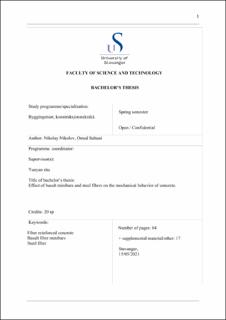| dc.contributor.advisor | Sha Yanyan | |
| dc.contributor.author | Sultani Omid og Nikolov Nikolay | |
| dc.date.accessioned | 2021-09-07T16:28:23Z | |
| dc.date.available | 2021-09-07T16:28:23Z | |
| dc.date.issued | 2021 | |
| dc.identifier | no.uis:inspera:78877253:36755633 | |
| dc.identifier.uri | https://hdl.handle.net/11250/2774345 | |
| dc.description.abstract | | |
| dc.description.abstract | The use of steel reinforcement in the form of rebar has been used for many years to improve
the tensile and flexural strength of concrete elements. The research and development within
the field of concrete is ever expanding due to concrete being the most readily available and
widely used construction material. The use of fibers in concrete is not an entirely new concept
however increasing amounts of fiber types and materials are being introduced into the market.
The mechanical behavior and properties of each of these fibers can drastically differ from each
other and constant research is therefore being performed to better understand how different
types of fiber reinforced concrete behave.
In this bachelor thesis tests were performed on two types fiber types, conventional steel hooked
end smooth fibers and basalt fiber Minibars. The basalt fiber Minibars are a rather new
technology which consist of many small micro-fiber basalt filaments that have been spun
together to form large macro-fibers of length between 30-50 mm. These Minibars are supposed
to act similar to traditional steel fibers by increasing the concretes flexural capacity through
acting as tension bridges and limiting crack prorogation.
Volume fractions of 0.5% and 1% were tested for both fiber types and compared to plain
concrete. The steel fibers showed a notable increase in compressive strength mean while the
basalt fiber Minibars reduced the compressive strength proving to be insufficient at serving as
compressive reinforcement. The steel fibers showed no significant increase or decrease when
it came to the ultimate flexural strength of the concrete while the basalt fiber minibars caused
a notable reduction in flexural strength. The fibers seemed ineffective at increasing the ultimate
flexural strength of the concrete, they did however show exceptional post cracking behavior by
increasing the concretes ability to carry loads past failure. Additionally, improved modes of
failure were observed due to the significantly increase ductility of the fiber reinforced concrete. | |
| dc.language | eng | |
| dc.publisher | uis | |
| dc.title | Effect of basalt minibars and steel fibers on the mechanical behavior of concrete. | |
| dc.type | Bachelor thesis | |
